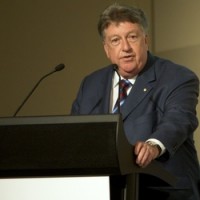 |
Chantal Jacobs rides past jacaranda trees at the University of Queensland's St Lucia campus. |
THE brilliant reds, purples and shade of the southeast's subtropical trees have formed part of the region's spring and summer landscape for more than a century in some cases.
However in the face of a recent run of dry weather and the increasing age of some trees, the battle to preserve them is a constant one.
The magnitude of that fight hit home in Ipswich this month, when two 80-year-old jacarandas came crashing to the ground in Brisbane Tce and George St at Goodna during a windy day.
With Goodna's annual Jacaranda Festival due to go ahead next Friday, Councillor Paul Tully said Ipswich City Council had plans to replace the fallen trees and would make arrangements to ensure the iconic jacarandas did not disappear for good.
"They were planted 80 years ago this year, and they have survived three floods," he said.
"The old trees, I do think some of them are on their last legs. We are going to swing into action now with a plan to plant a new jacaranda in between each of the existing old ones."
 |
Brodie Bannister enjoys the shade of a Moreton Bay fig in Kelvin Grove. |
Cr Tully said council had a responsibility to weigh up issues of public safety against preserving the environment.
He added he was increasingly aware of public concerns about large trees, particularly older eucalypts.
"It really is a difficult issue, because you might have a really magnificent tree.
"They don't last forever and people might think they will but they get old, they lose branches, they get rot in them and diseased sooner or later but it is important for councils to replenish trees to ensure that you don't just cut out the old ones and leave nothing."
While the sight of a blooming jacaranda or poinciana are familiar to many, the reason for their abundance in Brisbane may not be.
Cr Tully said council had a responsibility to weigh up issues of public safety against preserving the environment.
He added he was increasingly aware of public concerns about large trees, particularly older eucalypts.
"It really is a difficult issue, because you might have a really magnificent tree.
"They don't last forever and people might think they will but they get old, they lose branches, they get rot in them and diseased sooner or later but it is important for councils to replenish trees to ensure that you don't just cut out the old ones and leave nothing."
While the sight of a blooming jacaranda or poinciana are familiar to many, the reason for their abundance in Brisbane may not be.
 |
| BIG REDS: Blooming poincianas in a St Lucia street. |
Introduced poincianas and jacarandas have featured in Queensland parks for more than a century, but it was Harry Oakman, Brisbane's superintendent of parks from 1945 to 1962, whose vision left a lingering impact.
His mission to adorn Brisbane in the flowering trees, as well as Moreton Bay figs, can be witnessed annually as the fruits of that labour bloom.
With almost 800 trees of varying species located in and around the Brisbane CBD alone, and hundreds more dotted through the city's suburbs, Brisbane's City Council's team of arborists seeks to preserve this legacy by replacing "like with like" where possible, as the trees reach the end of their natural lives.
The recent big dry has also presented challenges as council officers conduct regular inspections of the city's foliage to address threats posed by weather and old age.
A spokesman for Lord Mayor Graham Quirk said while some smaller trees were suffering in the drier weather, most were faring well.
 |
| RELAXING ATMOSPHERE: Andrew Greenhalgh and Christina Rucker lounge in the sun against a jacaranda at St Lucia. |
Council has a number of processes for collecting information on the city's trees, which include regular inspections of parks, problem trees and trees located in the CBD," he said.
"Council does have records of most of the city's oldest trees but none of these are of concern due to the current dry conditions. These trees have survived many droughts and generally have very deep root systems."
"Most are located in council's older parks such as the Botanic Gardens, and as such, are watched very closely by Councils gardeners. The CBD contains a number of very old fig trees. These trees have deep root systems and are highly resilient to drought."
www.CourierMail.com.au
20.10.12








